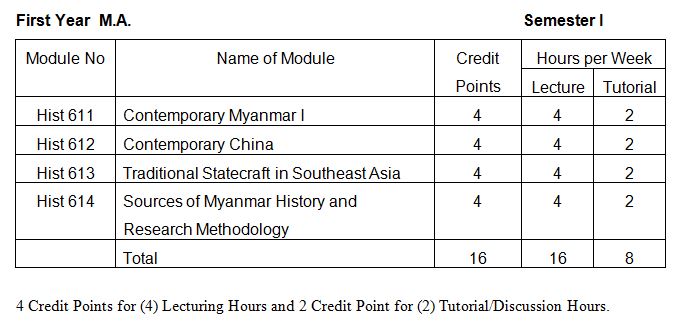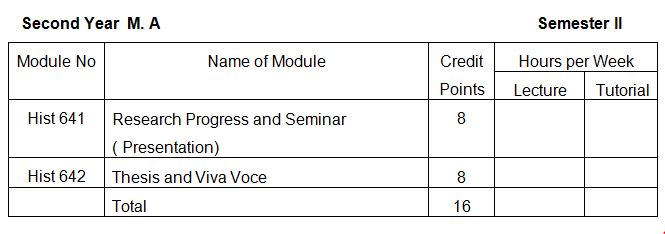MA


Contemporary Myanmar II
First Year MA (History) (Semester-II)
Core course for History Specialization (Hist-621)
I. Introduction
- Locating the content of the course within the discipline
- Locating the course within the curriculum
a. Locating the content of the course within the discipline
This course focuses on the contemporary Myanmar history from the prelude to democratization in Myanmar to emergence of new government formed by NLD Party. This course covers the wide range of the topics, including Saffron Revolution, Cyclone Nargis , 2008 Constitution , the new cabinet and the new changes , challenges in economic reforms , national reconciliation and peace process.
b. Locating the course within the curriculum
The course is a part of M.A. Degree for First year MA (History Specialization) students of University of Yangon.
II-III. Aims and Learning outcomes
- Academic Aims, Goals
- Learning Outcomes (objectives)
a. Aims:
The course aims are as follows:
- To analyze the democratization process of Myanmar
- To discuss the challenges in Peace Process
b. Learning Outcomes:
After participation in class discussions and assignments, students should be able to:
- demonstrate how different political institutions, actors and processes shape Myanmar politics, comprehend the multiple trajectories and contestations of Myanmar democracy
By the end of the semester students would be able to:
- develop skills in research, analysis, presentation and writing on Myanmar politics.
IV. Structure of the course
The course is structured in three broad sections. The first part examines prelude to democratization in Myanmar. The second part of the course illustrate democratization of Myanmar between 2011 to 2015 . The third part of the course includes 2015 Election and emergence of new government formed by NLD Party.
Myanmar Art and Architecture
M.A. First Year (Semester-II)
Core course for History Specialization (Hist -624)
I. Introduction
- Locating the content of the course within the discipline
- Locating the course within the curriculum
a. Locating the content of the course within the disciplined
The course is composed of many parts: basic terms of architecture in Myanmar, Mudrā and Āssana (Hand and foot postures of the Buddhist Art), stūpa (pagoda/solid type) and its architecture, gū (temple/ hollow type) and its architecture, Mon art and architecture and its significances, terracotta artifacts of Myanmar, Paintings of Bagan.
b. Locating the course within the curriculum
The course is a part of M.A. Degree for First year MA (History Specialization) students of University of Yangon.
II-III. Aims and Learning outcomes
- Academic Aims, Goals
- Learning Outcomes (objectives)
a. Aims:
The course aims are as follows:
- To know about the value of art and architecture,
- To interpret the ancient history of Myanmar and its descending, influence and links with other cultures.
b. Learning Outcomes:
After participation in class discussions and assignments, students should be able to:
- Interpret the inscriptions, religious monuments and iconography which are important sources to history.
By the end of the semester students would be able to:
- provide the candidates how to historically interpret on artifacts,
- obtain an important knowledge dealing with the artifact or remain and its periodization, and
- evaluate art and architecture of a certain period by doing comparative study.
IV. Structure of the course
The course is composed of art and architectural terms of Myanmar tradition, architecture of stupa, and temple, and images, i.e. statue, relief, paintings and these types and styles. The course contains three parts: in the first part, students study on art and architectural terms as a fundamental knowledge. In the second part, study is made on stupa and its type and style. In the third part, students will learn iconographic study including the Buddha, monks, deities, laymen and depictions of Jataka stories. In the fourth part, students do study on art and architecture during the Pyu period, Bagan, and succeeding periods in Myanmar history.



